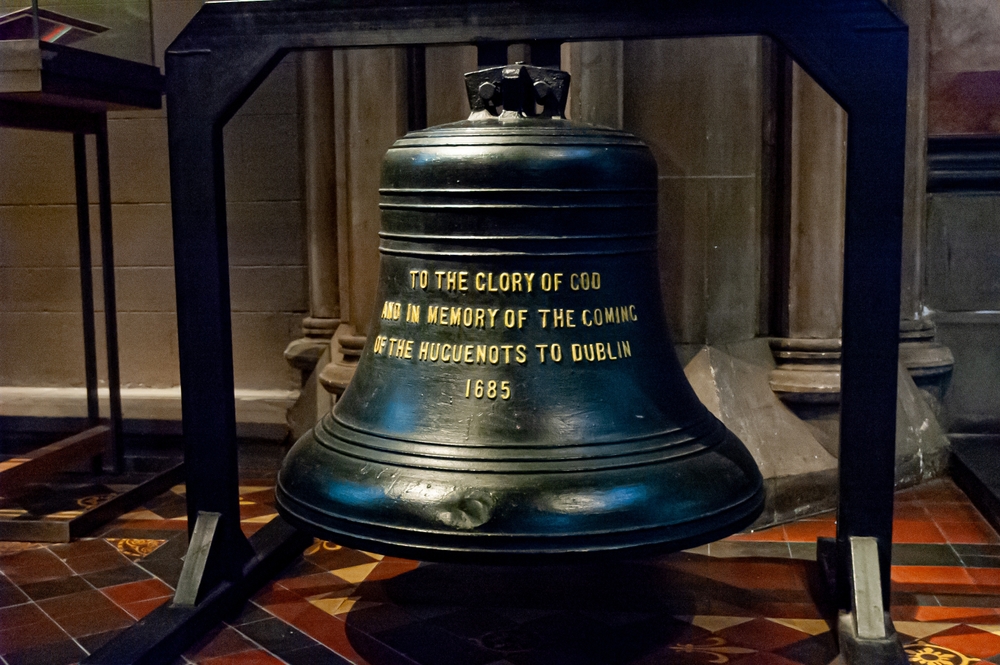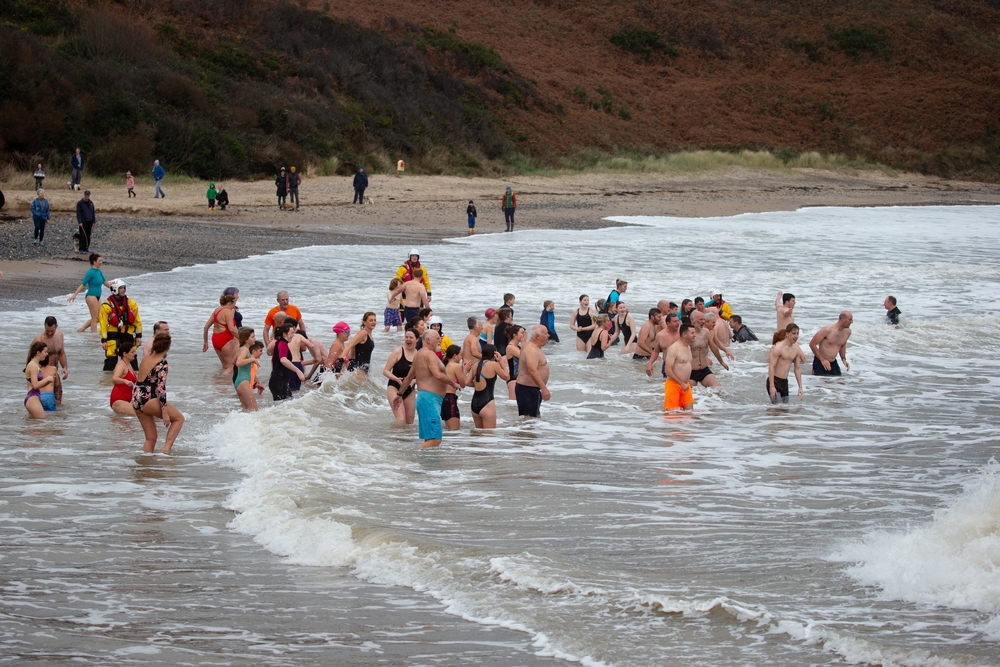3 Irish New Year’ Traditions that Stand Out: Ringing of the Bells, First-Footing, New Year’s Day Swim
Irish New Year traditions are a fun mix of celebratory rituals, superstition, and communal spirit. The ringing of the bells on New Year’s Eve fills the air with joyous melodies, while first-footing as the clock strikes midnight is a symbolic way to welcome good fortune into the home, rooted in Irish tradition. And, the New Year’s Day Swim, where participants plunge into chilly waters, is a celebration of new beginnings, marked by laughter, cheers, and a sense of camaraderie. Together, these traditions create a vibrant and unique New Year’s experience that reflects the heart and soul of Irish culture.
Ringing of the bells: an Irish tradition welcoming the New Year

Huguenot Bell, St Patrick’s Cathedral. Dublin, Ireland | Shutterstock | 2163586077 | Fabio Pagani
The tradition of ringing bells on New Year’s Eve is a joyous celebration that heralds the arrival of the new year. It’s a widespread practice embraced by cathedrals, churches, and homes alike, so once the clock strikes midnight, you’ll be greeted with an awesome cacophony of sound that sweeps the country. In particular, the annual New Year Festival 2024 at Christ Church Cathedral, Dublin features an open-air countdown concert, light show, and procession, while the cathedral’s sixteen pealing bells also sound proudly, ringing in the new year. Ultimately, the ringing of the bells is a way for the Irish people to bid farewell to the old year and usher in the new one with optimism and hope. This tradition is also often part of larger festivities attended by locals and visitors alike. Featuring fireworks and music, these gatherings transform into lively parties, creating a celebratory atmosphere for everyone to enjoy.
Stepping into good fortune: the timeless tradition of first-footing
The first foot through the door after midnight on New Year’s Eve can be a sign of good luck in Ireland. In times past, Irish residents hoped the first person through their doors on this night would be a tall, dark-haired man bearing coveted New Year’s presents for the family — whiskey for warmth, food for sustenance, and a silver coin for prosperity. This type of visitor was believed to set a positive tone for the household’s fortunes in the upcoming year. Anyone who turned up without a gift would be denied entry until the “first footer” was already present and accounted for, and with all the expected offerings. The arrival of a red-headed woman, on the other hand, was a bad omen — even if she came bearing gifts. Needless to say, red heads back in the day tended to give New Year’s celebrations a miss.
The concept of luck holds significant importance in Irish folklore, traditions, and everyday life. And, on New Year’s Eve, any negative happenings were considered to carry more weight, especially as the clock approached midnight. The Irish believed that the world held a finite amount of luck, prompting them to take every conceivable action to ensure they claimed their share. In fact, families took first footing so seriously they even took steps to prevent bad luck. Anyone in the family blessed with dark hair would be ordered out of the house once the clock hit midnight, so they could then immediately step in through the front door, ensuring the symbolic act of welcoming good fortune into the home. Local boys in the area — as long as they had dark hair — would go door-to-door, where they would receive warm greetings, along with sweets or chocolates. Sometimes money was also gifted — usually a coin. Notably, first footing isn’t just a relic of times past; this tradition is actually still practised in various parts of Ireland, including Donegal and Derry.
New Year’s Day Swim: welcoming the new year with a splash

Wexford, Ireland January 1, 2022 On New Year’s Day, swimmers brave the frigid waters of the Irish Sea to take the traditional first swim of 2022 to raise funds for charity at Ballymore Beach. | Shutterstock | BW Press
In Ireland, the traditional New Year’s Day Swim is a spirited, celebratory, and often chilly tradition that takes place along the country’s coastlines and bodies of water. On the first day of the year, daring participants gather at iconic locations — such as, the Forty Foot in Sandycove, Dublin, or the scenic beaches of Galway — and plunge into the invigorating waters. This communal event, marked by laughter, cheers, and perhaps a few gasps, symbolises a collective embrace of new beginnings, fostering a camaraderie among those who brave the cold to welcome the year with a refreshing and symbolic dip.
The ringing of the bells, first-footing, and the New Year’s Day swim are timeless Irish New Year traditions. Together, they unite people in the joy of celebration and usher in the promise of a fresh start.
Written by Nina Hellman
Share This Story, Choose Your Platform!
Check out our other recent blog posts!
Unusual and Lesser-Known Irish Comfort Foods to Try This Winter
Unusual and Lesser-Known Irish Comfort Foods to Try This [...]
3 Irish New Year’ Traditions that Stand Out: Ringing of the Bells, First-Footing, New Year’s Day Swim
3 Irish New Year' Traditions that Stand Out: Ringing [...]
Temple Bar TradFest 2024!
Temple Bar TradFest 2024! Dates: 24th January - 28th [...]
Exploring the Heart of Irish Christmas: A Guide to the Best Festive Activities
Exploring the heart of Irish Christmas: A Guide to [...]
MAY you discover ancient Irish traditions?
MAY you discover ancient Irish traditions? Whether you are [...]
It’s Time to Go Green: Happy St Patrick’s Day!
It’s Time to Go Green: Happy St Patrick’s Day! [...]






